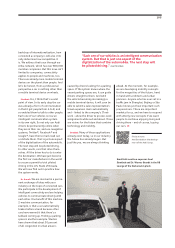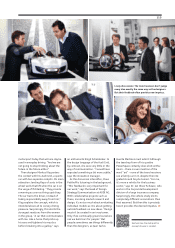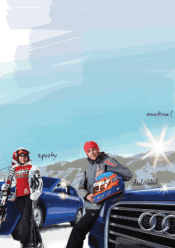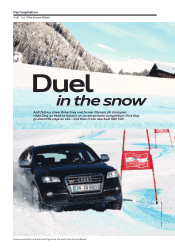Audi 2012 Annual Report Download - page 109
Download and view the complete annual report
Please find page 109 of the 2012 Audi annual report below. You can navigate through the pages in the report by either clicking on the pages listed below, or by using the keyword search tool below to find specific information within the annual report.
My Experience
Eager antici-
pation: Four
young Audi
designers (left)
present their
visions of
the future,
which are
then debated
intensely in a
group meeting
with the trend
receivers (right).
On this day, the future of
the automobile is not
being debated behind
the gates of large
plants
, but rather at
a small agency in Munich. There’s a
surfboard propped up against the door
and a soccer table next to the espresso
machine. Other than this, the creative
minds at gravity design agency have
cleared out their premises. Nothing
should divert the observers’ gazes and
thoughts from the objects located
on chest-high plat forms: four vehicle
studies by young Audi designers who
have made their individual visions of
the Audi of the future into reality –
as 1:4 scale models, at least. Two
women and three men then study the
models. They silently move from design
to design, jotting things down here
and there on yellow adhesive notes.
Their faces reveal nothing.
“I wonder what they’ll have to say,”
whispers designer Juan Carlos Huerta
Martinez to a colleague. The Spaniard
doesn’t take his eyes o the man in
the blue jacket who is currently exam-
ining his quattro PowerSpace, a high-
capacity sedan with large wing doors.
The design is meant to combine the
driving pleasure of a sporty Audi with
the roominess of a van. “Just because
you have a family doesn’t mean your
car shouldn’t be fun to drive,” says
Huerta Martinez, explaining his concept.
But will they understand it? Today’s
the day to find out.
It takes a lot of time to develop a
car – and a lot of money to build it.
That’s one reason why there is scarcely
a market as well researched as the
car market. Cockpit layout, glove box
styling, turn signal design – there are
surveys and studies on just about every
detail of a vehicle. Audi alone requests
feedback from car drivers in 70 to 80
studies each year. On the way to pro -
duc tion readiness, new models pass
through so-called car clinics, in which
they are analyzed and discussed down
to the smallest detail by test persons.
The information gleaned from the
clinics is incorporated into further pro-
duct design. By the time an Audi car
is launched on the market, its creators
already have a precise idea of the
emotions and associations it will evoke.
Juan Carlos Huerta Martinez’s glass
quattro PowerSpace is far from market-
ready; even further removed are the
more futuristic designs of his colleagues.
Take, for instance, the buggy-like Audi
quattrix whose cockpit rotates along
the longitudinal axis. It can jump and,
“like a cat, always lands on all fours,”
explains its creator Elmar Reich. Or the
ultra-flat vehicle by Björn Wehrli, which
with its fully faired wheels resembles
a catamaran. Its propulsion comes not
from an engine, but from the wind,
which is caught in a swiveling airfoil.
“Perhaps the car races of 2040 will take
place with this type of 80 km/h Speed-
sailor – with a zero carbon footprint,”
says the designer, describing his vision.
By now it’s clear that we’re not talk-
ing about Audi innovations for the
year 2014. This is also not your average
market research session – it’s called
a “trend receiver” analysis. Here, based
on personal visions of the Audi design-
ers, a select group of people with
vision get together to reflect on what
the mobility of the future could look
like. These are visions that could become
reality years or even decades from now
– or perhaps never.
“When the timeline to market rel -
evance is particularly long or the
questions are extremely complex,
conventional market research reaches
its limits,” explains Dr. Rupert
Hofmann, who develops the trend
receiver studies for Audi. The partici-
pants he enlists for this dier from
those of a market-representative study.
These are not specifically automobile
experts, but rather individuals se lected
based on specific themes, who per -
ceive changes early on and are good
at discerning the potential of new con -
cepts. They are people from a whole
range of industries, but all have one
thing in common: They are exceptionally
curious, have connections in a range
of contexts and enthusiastically observe
what it is that drives people and what
things are changing.
These experts hold nothing back.
“I bet you couldn’t hold a teleconfer-
ence in it,” Bernd Blumoser quips
dryly in reference to Elmar Reich’s
buggy. Blumoser, who is responsible
for Corporate Technology for Open
Innovation and Ideas Competitions
at a large firm, voices an opinion
that illustrates just how dierent
requirements for vehicles can be.
“Drivers will have to have a certain
amount of skill to control the Speed-
sailor – they won’t be able to rely
on the assistance system to handle
that,” jokes Birgit Schaldecker,
innovation manager at a high-tech
textile manufacturer, referring to
Wehrli’s design. On the other hand,
she says, thinking aloud, technologies
are already being developed for
P H O T O S | U L R I K E M Y R Z I K
112
























